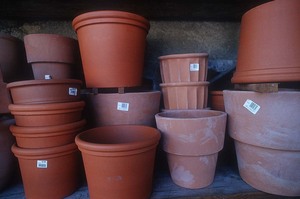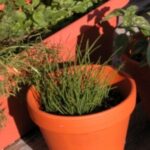Gardening in containers is popular throughout the growing seasons, but can become a challenge during the winter months. It depends on where you live, but extra precautions sometimes need to be taken in the winter months to help container plants survive the cold. The temperature of soils in containers during the winter can fluctuate much more quickly than the soil in the ground. This can cause the roots to be injured from intermediate freezing and thawing. This will occur even more if the container is sitting on patios or pavement due to the surface absorbing more heat from the sun during the day, but also getting even colder at night.
Keep the container plants watered in the winter if there are dry spells. There seems to be a misconception that plants don’t need water in the winter. The truth is that a dry plant is more easily damaged from freezing in the winter, just as a plant is more susceptible to damage from drought in the summer. Dry soil actually gets much colder than wet soil due to the dry soil having air pockets that allow frost into the soil. Water fills those air pockets in a moist soil and although the water freezes it protects the roots. Obviously, the climate and precipitation will help determine if watering the containers will be necessary. Evergreens grown in containers in the winter are especially prone to damage from drying out and it’s best to check the soil moisture occasionally. When in doubt about watering and an extreme cold spell is in the weather forecast, it’s better to water than to let the container plant suffer irreversible damage from freezing.
An easy way to help the container plants survive the winter is by grouping them together. Put them on the soil as near the house as possible. Group the containers by putting the largest with the most hardy plants on the outside of the group and the least hardy in the center of the group. Then use whatever materials or mulches you have available to insulate the group of containers. If you have hay bales left from autumn decorating, these would be perfect for circling around the outer pots of the group to protect them.
Plants in containers with thin walls will have a more difficult time surviving during the coldest part of winter. An easy solution is to set the container inside a larger container with thick walls. If there is a good amount of space between the two pots, then it can be used for extra insulation. Whatever happens to be on hand is what will work, because basically anything is better than nothing. Packing peanuts, bubble wrap, mulch, foam or even burlap or old blankets will work as insulation between the two containers.
Planning the container plants for winter earlier in the season would be the best defense, so next year good containers can be part of the plan. Clay and porous ceramic pots will crack during the winter freezes, but there are ways to prepare them to last through the winter. Prepare a clean dry clay pot by putting a waterproof sealant or pool paint on the interior of the pot. This can really help the pot not crack from moisture getting inside the porous walls.
Non-porous containers like concrete and plastic make good choices for staying out in the winter weather, just use the thickest walls available no matter the container’s material. A very thin plastic container is not going to offer much protection for the plant’s roots. The new lightweight resin and foam containers often have very thick walls and these are good alternatives to concrete. Because they are so lightweight, they can easily tip over. Put several heavy rocks in the bottom of the containers before repotting plants in them.
Always try to use the largest pot possible with outdoor container plants, it will really help protect them not only from drought in the summer, but will help them survive the winter months as well. Another trick to help container plants survive the winter is to purchase plants hardy to about 20 degrees colder or two USDA Zones cooler than your Zone. For instance if your USDA Zone is 6, then purchasing a plant hardy to Zone 4 would assure winter survival in a container.




